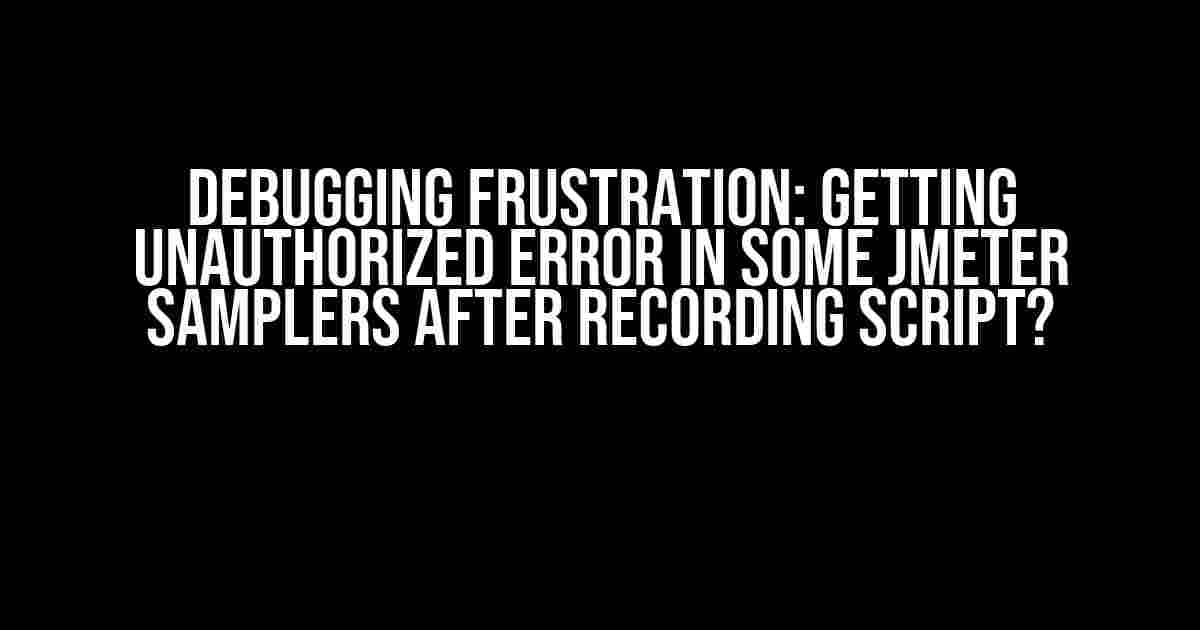Are you tired of encountering the “Getting Unauthorized Error” in some JMeter Samplers after recording a script? You’re not alone! This pesky error can be a major roadblock in your performance testing journey. But fear not, dear reader, for we’re about to embark on a troubleshooting adventure to conquer this issue once and for all!
What’s Causing the Unauthorized Error?
Before we dive into the solutions, let’s quickly understand what might be causing this error. The “Getting Unauthorized Error” typically occurs when JMeter is unable to authenticate or authorize with the server. This can happen due to various reasons, including:
- Invalid or missing credentials (username, password, or token)
- Incorrect configuration of the HTTP Request Defaults or HTTP Request Sampler
- Server-side issues, such as authentication mechanisms or firewall restrictions
- Cookie management or session handling issues
Step 1: Verify Credentials and Configuration
The first step in resolving the Unauthorized Error is to double-check your credentials and configuration. Ensure that:
- Username and password are correct and match the server-side configuration
- HTTP Request Defaults or HTTP Request Sampler is properly configured
- Any authentication mechanisms, such as OAuth or NTLM, are correctly set up
- Cookies are being handled correctly, and sessions are being managed properly
// Example of correct HTTP Request Defaults configuration
HTTP Request Defaults
{
Protocol: http
Server: example.com
Port: 80
Path: /login
Method: POST
Implementation: Java
Follow Redirects: true
Auto Redirects: true
Use KeepAlive: true
Connection: keep-alive
Content-Type: application/x-www-form-urlencoded
Username: your_username
Password: your_password
}
Step 2: Enable Debug Logging
Enable debug logging to get a better understanding of what’s happening behind the scenes. This will help you identify the root cause of the Unauthorized Error.
To enable debug logging in JMeter:
- Go to the “Run” menu and select “Non-GUI Mode” (or press Ctrl + Shift + F)
- In the command-line interface, add the following argument:
-L DEBUG - Run your test script again and observe the debug logs
// Example debug log output
2019-12-16 14:30:00,123 DEBUG o.a.j.p.h.c.HttpClient4Impl: Sending request: POST /login HTTP/1.1
2019-12-16 14:30:00,123 DEBUG o.a.j.p.h.c.HttpClient4Impl: Sending request headers:
2019-12-16 14:30:00,123 DEBUG o.a.j.p.h.c.HttpClient4Impl: Content-Type: application/x-www-form-urlencoded
2019-12-16 14:30:00,123 DEBUG o.a.j.p.h.c.HttpClient4Impl: Authorization: Basic your_username:your_password
Step 3: Inspect HTTP Request Headers and Cookies
Inspect the HTTP request headers and cookies to ensure that authentication credentials are being sent correctly.
In JMeter, you can view HTTP request headers and cookies using:
- HTTP Request Sampler > Request > Request Headers
- HTTP Request Sampler > Request > Cookies
// Example HTTP request headers
Connection: keep-alive
Content-Type: application/x-www-form-urlencoded
Authorization: Basic your_username:your_password
| Cookies | |
|---|---|
| Cookie Name | Cookie Value |
| JSESSIONID | your_session_id |
Step 4: Check Server-Side Configuration
Verify that the server-side configuration is correct and allows authentication from your JMeter script. Check:
- Server-side authentication mechanisms and firewall restrictions
- Server logs for any authentication-related errors
- API documentation for any specific authentication requirements
Step 5: Use a HTTP Proxy Server
If you’re still stuck, try using a HTTP proxy server to capture and inspect the HTTP traffic between JMeter and the server. This can help you:
- Debug HTTP request and response headers
- Verify authentication credentials and cookies
- Identify any server-side issues or misconfigurations
Popular HTTP proxy servers include:
- Fiddler
- Burp Suite
- Charles Proxy
Conclusion
Getting Unauthorized Error in some JMeter Samplers after recording a script can be frustrating, but by following these steps, you should be able to identify and resolve the underlying issue. Remember to:
- Verify credentials and configuration
- Enable debug logging
- Inspect HTTP request headers and cookies
- Check server-side configuration
- Use a HTTP proxy server for debugging
With patience and persistence, you’ll be able to overcome the Unauthorized Error and successfully execute your JMeter script!
Frequently Asked Question
Stuck with those pesky unauthorized errors in JMeter? Don’t worry, we’ve got you covered! Here are some frequently asked questions and answers to help you resolve those annoying errors.
Why am I getting unauthorized error in some JMeter samplers after recording a script?
One possible reason is that the script recorder doesn’t capture all the necessary requests, such as login requests or requests that set up session cookies. You might need to correlate these requests manually or use a tool like HTTP Analyzer to capture the entire conversation between your browser and the server.
How do I handle authentication and authorization in JMeter?
You can use the HTTP Authorization Manager to handle authentication and authorization. This component allows you to specify the authentication method, such as Basic, Digest, or NTLM, and the credentials to use. You can also use the HTTP Cookie Manager to store and send cookies, which is essential for maintaining sessions.
Can I use a proxy server to capture requests and avoid unauthorized errors?
Yes, you can use a proxy server like Fiddler or Burp Suite to capture requests and responses. This can help you identify the requests that are causing the unauthorized errors and fix the corresponding samplers in JMeter. Just make sure to configure the proxy server to capture HTTPS traffic as well.
What if I’m still getting unauthorized errors after configuring the HTTP Authorization Manager?
Check the server response to see if there are any error messages or hints about what’s going wrong. You can also try using a tools like Postman or cURL to test the requests manually and see if you get the same error. Sometimes, it’s a simple typo or a missing header that’s causing the issue.
Are there any best practices to avoid unauthorized errors in JMeter?
Yes, always follow these best practices: record your script in a controlled environment, use a proxy server to capture requests, and manually review and correlate the requests. Also, make sure to test your script in dev mode before running it in production, and always analyze the server response to identify potential issues.
